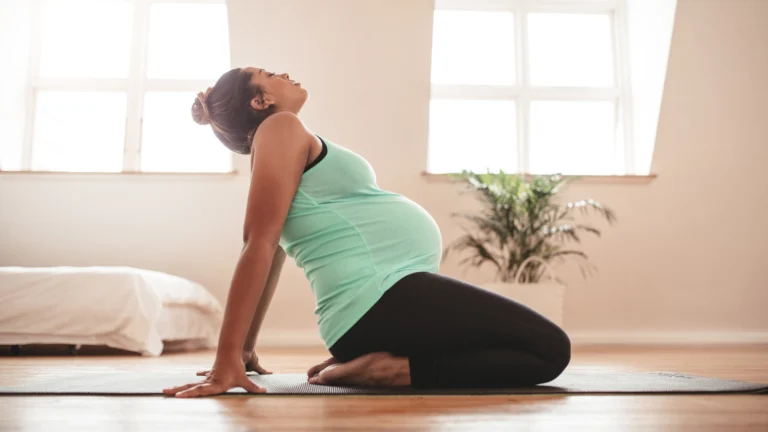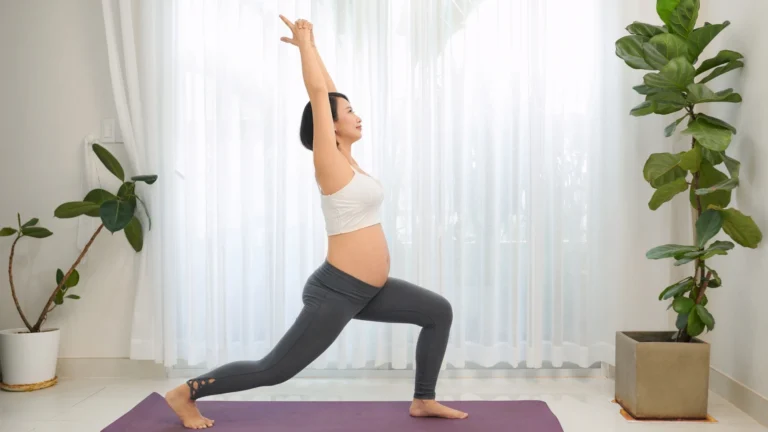Is Kapalbhati Safe During Pregnancy?
Pregnancy is a transformative journey marked by physical and emotional changes. Expectant mothers often seek ways to maintain their well-being, and one practice that has gained popularity is Kapalbhati, a yogic breathing technique known for its potential health benefits. However, the safety of Kapalbhati during pregnancy is a subject that warrants thoughtful consideration. In this blog, we delve into the potential advantages and risks associated with Kapalbhati during pregnancy, providing insights to help expectant mothers make informed decisions about their well-being.Understanding Kapalbhati
 Kapalbhati, derived from the Sanskrit words ‘kapal’ (forehead) and ‘bhati’ (shining), is a pranayama technique that involves forceful exhalations and passive inhalations. Practitioners often describe the sensation as a rhythmic contraction and release of the abdominal muscles, generating heat and energy within the body. This traditional yogic practice is believed to offer numerous health benefits, including improved lung capacity, enhanced digestion, and increased mental clarity.
Kapalbhati, derived from the Sanskrit words ‘kapal’ (forehead) and ‘bhati’ (shining), is a pranayama technique that involves forceful exhalations and passive inhalations. Practitioners often describe the sensation as a rhythmic contraction and release of the abdominal muscles, generating heat and energy within the body. This traditional yogic practice is believed to offer numerous health benefits, including improved lung capacity, enhanced digestion, and increased mental clarity.
Potential Benefits of Kapalbhati During Pregnancy
The following are the benefits of practising Kapalbhati during pregnancy.- Improved Respiratory Function: Kapalbhati, a breathing technique, entails rhythmic, forceful exhalations and passive inhalations. It improves respiratory function by enhancing lung capacity and facilitating efficient oxygen exchange. During pregnancy, the expanding uterus may induce breathlessness due to diaphragmatic pressure. Kapalbhati’s controlled breathing alleviates this discomfort, promoting overall respiratory well-being by ensuring a steady flow of oxygen. Practicing Kapalbhati through online pregnancy yoga classes offer expectant mothers a mindful approach to manage respiratory challenges and contribute to their overall health during this transformative period.
- Stress Reduction and Relaxation: Pregnancy can increase stress and emotions, but Kapalbhati, with its rhythmic breathing, soothes the nervous system, fostering relaxation and stress reduction. This technique encourages mindfulness, aiding expectant mothers in finding serenity amid the diverse physical and emotional changes accompanying pregnancy. Kapalbhati serves as a valuable tool for emotional well-being, offering a holistic approach to managing stress during this transformative journey.
- Enhanced Blood Circulation: Kapalbhati’s forceful exhalations stimulate blood circulation, benefiting both the expectant mother and developing fetus. This enhanced circulation ensures a consistent supply of oxygen and nutrients, crucial for the well-being of both maternal and fetal systems. Kapalbhati leads to adequate blood flow and contributes to a healthier pregnancy by supporting the essential physiological processes necessary for the growth and development of the baby while maintaining the overall health of the expectant mother. Improving your blood circulation doesn’t require spending a lot of time on Kapalbhati. Research indicates that dedicating just 15 to 20 minutes each day to this breathing exercise can significantly enhance blood flow to crucial organs in your body.
- Support for Digestive Health: Pregnancy hormones can impact digestion, causing bloating and constipation. Kapalbhati’s focus on abdominal contractions acts as a natural internal organ massage, promoting digestive health. The rhythmic movements may alleviate common digestive discomforts, fostering a more balanced digestive system during pregnancy. Kapalbhati becomes a beneficial practice to mitigate digestive issues and contribute to the overall well-being of expectant mothers by supporting a healthier gastrointestinal function.
- Maintenance of Core Strength: Gentle exercise is recommended during pregnancy, and Kapalbhati offers a low-impact method to engage core muscles. The controlled contractions and releases in the abdominal area help maintain core strength without straining the body. A strong core supports the spine, aids in posture, and contributes to overall physical well-being, making Kapalbhati a valuable addition to a pregnancy fitness routine that prioritizes safety and the well-being of both the mother and baby.
- Energizing the Body: During pregnancy, feeling tired is common, especially in the first and third trimesters. Kapalbhati, with its energizing nature, can help boost your energy. The rhythmic breathing and extra oxygen intake wake up your body, making you feel more alive and vital. This is particularly helpful for pregnant moms dealing with different energy levels at various stages of pregnancy. Kapalbhati offers a natural and simple way to fight fatigue and support your well-being during this special time.
- Mind-Body Connection and Emotional Well-being: Kapalbhati promotes a strong mind-body connection by emphasizing focused breath awareness. Online yoga classes help pregnant women to practice kapalbhati cultivating mindfulness and presence, enabling expectant mothers to connect with their evolving bodies and the life developing within. Beyond stress reduction, Kapalbhati’s emotional benefits contribute to maintaining a positive and grounded mental state throughout the pregnancy journey. It serves as a valuable tool for emotional well-being, fostering a deeper understanding and appreciation of the transformative experience of pregnancy.
Risks and Considerations
 While Kapalbhati may offer some benefits during pregnancy, it’s essential to know about the possible risks. The main issue is that the forceful breathing involved can increase pressure inside the belly, especially in later pregnancy, potentially causing a separation of the abdominal muscles called diastasis recti.
The quick breathing in Kapalbhati can make you feel dizzy or lightheaded, which can be concerning when you’re pregnant. Some experts are cautious about the practice causing contractions in the uterus, even though there’s not a lot of evidence supporting this idea.
Every pregnancy is different, so it’s important to consider factors like your overall health, existing medical conditions, and how far along you are in your pregnancy. Always talk to your healthcare provider before trying Kapalbhati or any new exercise during pregnancy to make sure it’s safe for you and your baby.
While Kapalbhati may offer some benefits during pregnancy, it’s essential to know about the possible risks. The main issue is that the forceful breathing involved can increase pressure inside the belly, especially in later pregnancy, potentially causing a separation of the abdominal muscles called diastasis recti.
The quick breathing in Kapalbhati can make you feel dizzy or lightheaded, which can be concerning when you’re pregnant. Some experts are cautious about the practice causing contractions in the uterus, even though there’s not a lot of evidence supporting this idea.
Every pregnancy is different, so it’s important to consider factors like your overall health, existing medical conditions, and how far along you are in your pregnancy. Always talk to your healthcare provider before trying Kapalbhati or any new exercise during pregnancy to make sure it’s safe for you and your baby.
Guidelines for Practicing Kapalbhati During Pregnancy
If a pregnant woman is thinking about adding Kapalbhati into her prenatal fitness routine, it is crucial to do so under the guidance of a qualified healthcare professional or a certified prenatal yoga instructor. Here are some general guidelines to consider:
Here are some general guidelines to consider:
- Consultation with Healthcare Provider: Before introducing any new exercise or breathing routine during pregnancy, it’s imperative to consult with a healthcare provider. They can assess individual health conditions and provide personalized recommendations based on the specific needs of the mother and baby.
- Gentle Modifications: Modify the intensity of Kapalbhati by reducing the force of exhalations. Gentle and controlled breathing can still offer benefits without putting excessive strain on the abdominal muscles.
- Listen to Your Body: Pay close attention to how your body responds during and after practicing Kapalbhati. If you experience discomfort, dizziness, or any unusual symptoms, it’s crucial to stop the practice immediately and seek guidance from a healthcare professional. You can also read on Can You Do Yoga At 8 Months Pregnant to know more about pregnancy yoga
- Avoid Straining Abdominal Muscles: Pregnancy hormones can make connective tissues more pliable, increasing the risk of strains. Avoid overexertion and be mindful of not straining the abdominal muscles excessively.




 WhatsApp us
WhatsApp us